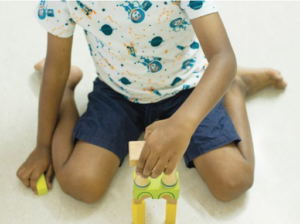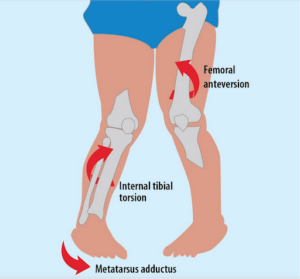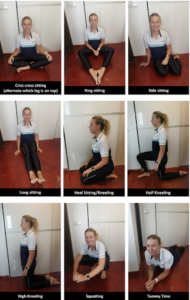
When watching your child play you may have noticed them sitting in a peculiar way. Looking from above you will see their little legs form the shape of a “W”. But what should you do when you see your child sitting in this position?
What is W-Sitting?
W-sitting is when your child sits with their legs rotated inwards and their knees in front of them with their feet back on either side of their hips. It is called W-sitting because of the shape the legs form when looking from above. It is a very common sitting position among kids, but can become a problem for your child if it is their preferred sitting position.
Why does my child W-Sit?
Children commonly choose to W-sit for comfort because it gives them a wide base of support and takes less strength to maintain an upright position. If a child has core weakness, excessive hip flexibility, or low muscle tone they can play without focusing on remaining balanced and upright if they choose to W-sit. Many kids W-sit and have no negative long term outcomes, but it can lead to some adverse effects for your child if they consistently choose this position.
Why is W-Sitting a problem?
The “W” position causes femoral anteversion and internal tibial torsion, which means the bones of the leg rotate inward. This inward position leads to stress on the knees and to possible in-toeing while walking, which is commonly called pigeon toe. When a child constantly stays in this position they create tightness in muscles within the hips, knees, and ankles. Weakness is also created within the core due to the lack of activation needed to maintain this position. Trunk rotation and bilateral coordination are also very limited while W-sitting. Overall, development of motor skills can be delayed due to all of the possible adverse effects caused by consistent W-sitting.

What should I do if I see my child W-Sitting?
Use verbal cues!
Choose a single phrase to use in order to help break the pattern of W-sitting. Whenever you see your child sitting this way use that phrase to cue them into choosing a better option for sitting. Keep the phrases positive to decrease the frustration your child may feel in having to change their position.
Some examples are:
“Fix feet/legs please!”
“Sit on your bottom please!”
“Feet in front!”
Help your child try alternative ways to sit!

These options will keep your child from experiencing impairments from consistent
W-sitting. Try out different sitting positions to find one that is comfortable for your child as they transition away from their habit of sitting in a “W” position.
Seek professional help!
Within physical therapy your child can learn many skills to break the habit of W-sitting. They will practice alternative methods of sitting, while also receiving verbal cues to guide them into better positions. Depending on your child’s impairments, physical therapy may focus on core strengthening, stretching, motor skills and more with many fun activities!
Questions or concerns?
If you have questions or concerns about your child’s motor skills, please contact us at info@playworkschicago.com or 773-332-9439.
Anna Mackey SPT
Physical Therapist Student
“All about w Sitting Position + Exercises to Help Correct It: Napa Center.” NAPA, 19 Jan. 2022, https://napacenter.org/w-sitting/.
at, Taisa, et al. “Experts Reveal the Truth about When to Worry about w Sitting.” Lemon Lime Adventures, 8 Feb. 2020, https://lemonlimeadventures.com/when-to-worry-about-w-sitting/.
Luca, et al. “W-Sitting: When It Is OK and When It Is Not Ok – Joyin – the Children’s Centre.” Joyin, 23 Feb. 2021, https://joyin.id/w-sitting-when-it-is-ok-and-when-it-is-not-ok/.
Photo credit:
Spd.org
Parentcircle.com
